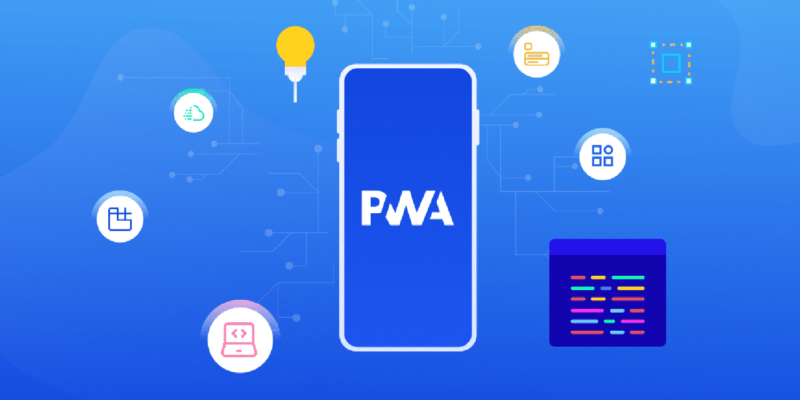
Progressive Web Apps (PWAs) have emerged as a game-changer, revolutionizing how users interact with web applications. With their ability to combine the best features of web and mobile apps, PWAs offer a seamless, fast, and engaging user experience across various devices and network conditions. In this article, we’ll delve into the concept of PWAs, explore their key features, benefits, and challenges, and discuss how businesses can leverage this technology to stay ahead in the digital landscape.
Understanding Progressive Web Apps (PWAs)
Progressive Web Apps (PWAs) represent a cutting-edge approach to web application development, leveraging contemporary web capabilities to provide users with an immersive, app-like experience. Developed using standard web technologies like HTML, CSS, and JavaScript, PWAs are imbued with additional functionalities that mimic the behavior of native mobile applications.
Designed to be reliable, swift, and captivating, these apps offer users the convenience of offline access and boast features such as push notifications and home screen installation. Web development company play a pivotal role in creating and optimizing PWAs, harnessing their expertise to ensure seamless performance and enhanced user engagement.
Key Features of Progressive Web Apps
- Progressiveness: PWAs are designed to work for every user, regardless of the browser choice, ensuring a consistent experience across different platforms.
- Responsiveness: They are responsive and adapt to various screen sizes, making them accessible on desktops, tablets, and smartphones.
- Connectivity independence: PWAs can function even in low or no network conditions by utilizing service workers to cache content and enable offline access.
- App-like experience: PWAs offer native app-like interactions and navigation, providing a smooth and immersive user experience.
- Installability: Users can install PWAs directly to their device’s home screen without the need for an app store, enhancing accessibility and visibility.
- Discoverability: PWAs are easily discoverable through search engines, making them more accessible to users.
- Security: PWAs are served over HTTPS, ensuring data integrity and security for both users and developers.
Benefits of Progressive Web Apps
- Improved User Experience: PWAs offer a seamless and engaging user experience, with fast load times, smooth navigation, and offline access, leading to increased user satisfaction and retention.
- Increased Reach: With PWAs, businesses can reach a broader audience as they are accessible across various devices and platforms, eliminating the need for separate development efforts for different operating systems.
- Cost-Effectiveness: Developing a single PWA that works across platforms can be more cost-effective than building and maintaining separate native apps for each platform.
- Enhanced Performance: PWAs are optimized for performance, with features such as lazy loading and caching, resulting in faster load times and improved responsiveness.
- Offline Functionality: One of the most significant advantages of PWAs is their ability to work offline, allowing users to access content and functionality even in the absence of a reliable internet connection.
- Engagement: PWAs can leverage features such as push notifications to re-engage users and drive higher user engagement compared to traditional web apps.
- Seamless Updates: PWAs are updated automatically, ensuring that users always have access to the latest version without the need for manual updates or app store approvals.
Challenges and Considerations
While PWAs offer numerous benefits, there are also challenges and considerations that developers and businesses need to address:
- Limited Browser Support: Although support for PWAs is growing, not all browsers fully support PWA features, which can limit functionality for some users.
- App Store Limitations: While PWAs can be installed directly from the web, they may not have access to all the features and functionalities available to native apps distributed through app stores.
- Complexity: Building and maintaining PWAs can require additional expertise and resources, especially when implementing features such as service workers and offline caching.
- Performance Optimization: Ensuring optimal performance across different devices and network conditions requires careful optimization and testing.
- Security Concerns: PWAs, like any web application, are susceptible to security vulnerabilities such as cross-site scripting and injection attacks, highlighting the importance of robust security measures.
- Discoverability: While PWAs are easily discoverable through search engines, they may not enjoy the same level of visibility as native apps in app stores, which can impact user acquisition and engagement.
How Businesses Can Leverage PWAs
- Enhance User Engagement: Businesses can leverage PWAs to deliver personalized experiences and drive higher user engagement through features such as push notifications and offline access.
- Expand Reach: By developing PWAs that are accessible across various devices and platforms, businesses can reach a broader audience and maximize their online presence.
- Improve Conversion Rates: PWAs can help businesses improve conversion rates by providing a fast, seamless, and immersive user experience that encourages users to interact with their products or services.
- Reduce Development Costs: Developing a single PWA that works across platforms can be more cost-effective than building and maintaining separate native apps for each platform, allowing businesses to allocate resources more efficiently.
- Increase Brand Visibility: PWAs can be easily discovered through search engines, social media, and other online channels, helping businesses increase their brand visibility and attract new customers.
- Streamline Updates and Maintenance: With automatic updates and seamless deployment, businesses can streamline the process of updating and maintaining their PWAs, ensuring that users always have access to the latest features and improvements.
- Provide Offline Access: By enabling offline access, businesses can ensure that users can access their content and services even in low or no network conditions, improving user satisfaction and retention.
Conclusion
Progressive Web Apps represent a significant evolution in web development, offering businesses the opportunity to deliver fast, reliable, and engaging experiences to their users across various devices and network conditions. With their ability to combine the best features of web and mobile apps, PWAs are poised to reshape the digital landscape and drive innovation in the years to come. By embracing PWAs and harnessing their power, businesses can stay ahead of the curve, expand their reach, and deliver exceptional experiences that delight their users.











